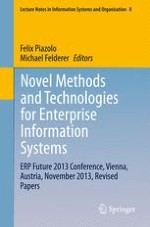2014 | OriginalPaper | Buchkapitel
Weaving Social Software Features into Enterprise Resource Planning Systems
verfasst von : Dirk Draheim, Michael Felderer, Viktor Pekar
Erschienen in: Novel Methods and Technologies for Enterprise Information Systems
Aktivieren Sie unsere intelligente Suche, um passende Fachinhalte oder Patente zu finden.
Wählen Sie Textabschnitte aus um mit Künstlicher Intelligenz passenden Patente zu finden. powered by
Markieren Sie Textabschnitte, um KI-gestützt weitere passende Inhalte zu finden. powered by
